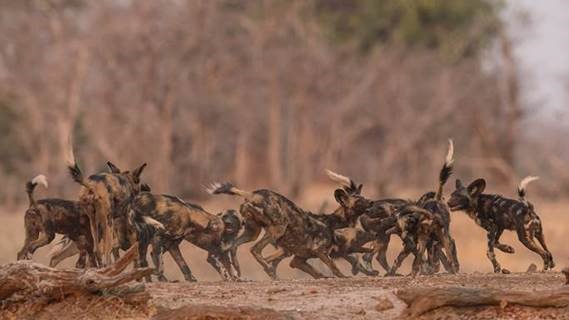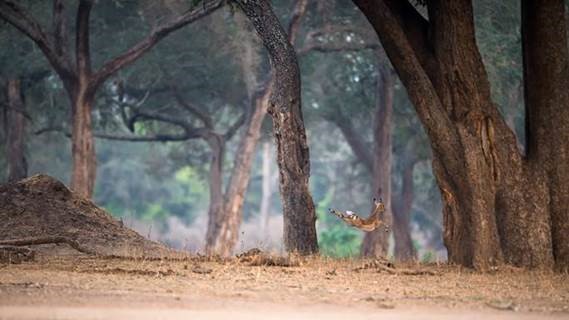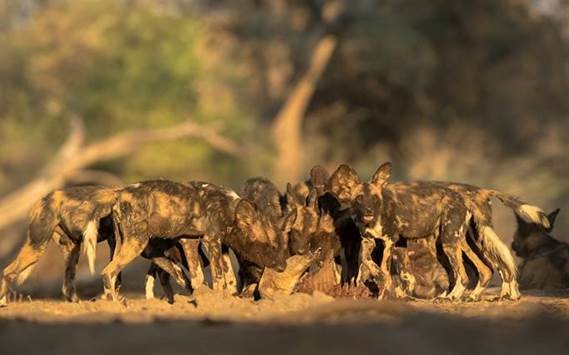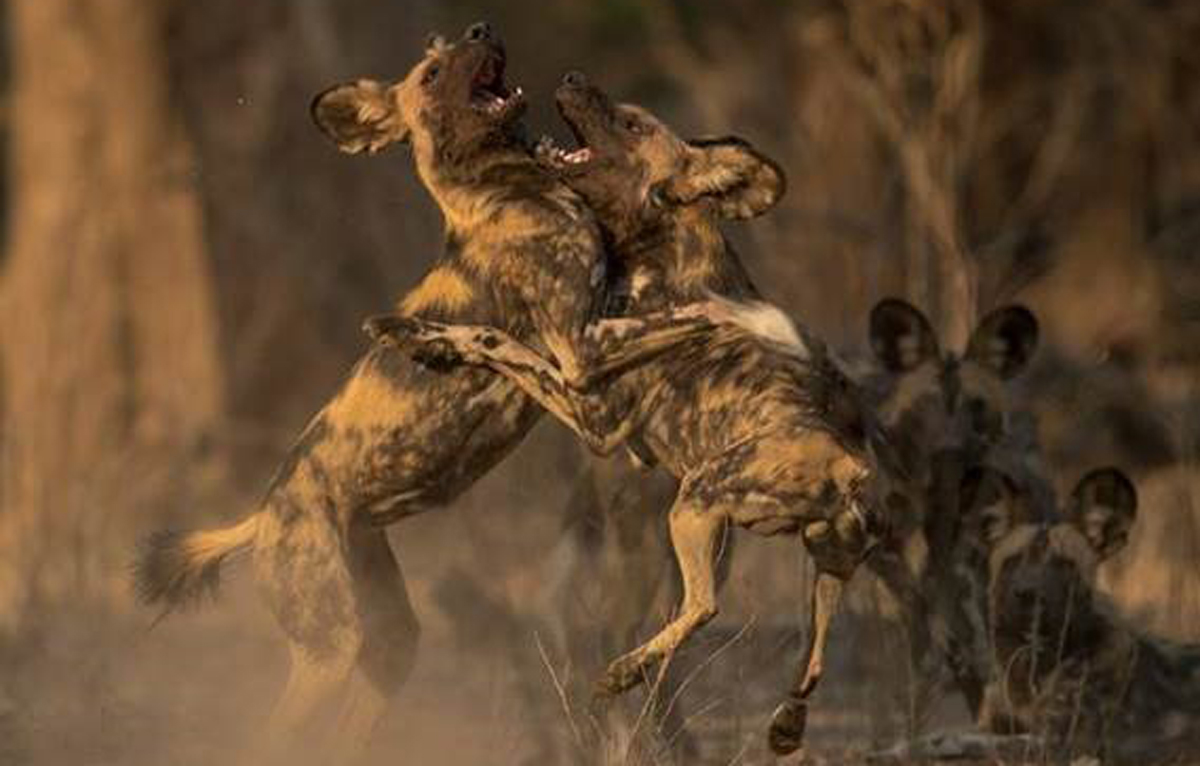 Painted Wolves Article From Africa Travel
Painted Wolves Article From Africa Travel
Introducing Nick Dyer who co-founded the Painted Wolf Foundation to highlight and raise awareness of the plight of Wild Dogs across Africa. Here is a story Nick wrote for Travel Africa along with some of his excellent photographs and a short video (below).
It is 45 degrees Celsius and the heat pounds my whole being even though an Albida tree shades me and the sun is heading fast towards the horizon. I am sitting on the thorny floodplain of the Zambezi Valley in Mana Pools National Park, Zimbabwe. In front of me rests my camera on its tripod. Twenty metres beyond lies a group of sleeping creatures that I have come to adore above any other in Africa…the painted wolves.
To me they are not just animals. It is Blacktip and her 14-strong pack with their brood of nine, six-month-old puppies. In reality, all the pups are Blacktip’s, as the alpha female is the only one to breed. But the rest of the pack members assume their roles of doting aunts and uncles, babysitters and playmates, guardians and defenders to make collective responsibility the pack’s modus operandi.
For the last five years, I have been tracking and photographing three packs of painted wolves on foot. These packs are led by three incredible alpha females; Blacktip, her mother Tait and sister Tammy. I have been with them almost daily for the last six months. I know each pack member as an individual and their acceptance of my presence on the ground suggests that they’ve also got to know me.
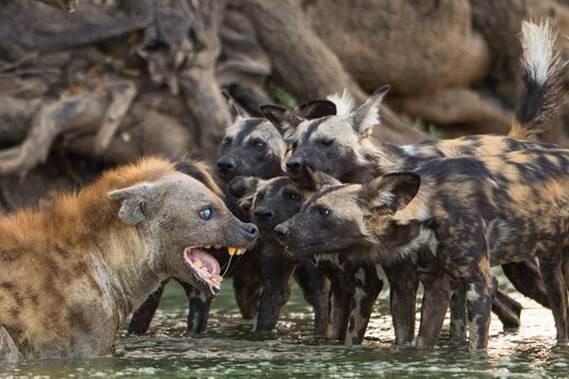 Blacktip has become the strongest of the three alphas and controls the centre of the park. Back in March she mated with her alpha male Hornet and 70 days later, when the rains had stopped, she found a suitable den in an old aardvark hole on a shady bank under a tall mopane tree. She dug out a few ‘emergency escape’ exits and then settled in to give birth to 12 tiny, blind pups. Each morning and evening, the rest of the pack would head off hunting, returning to feed their puppy-bound leader with regurgitated impala or baboon.
Blacktip has become the strongest of the three alphas and controls the centre of the park. Back in March she mated with her alpha male Hornet and 70 days later, when the rains had stopped, she found a suitable den in an old aardvark hole on a shady bank under a tall mopane tree. She dug out a few ‘emergency escape’ exits and then settled in to give birth to 12 tiny, blind pups. Each morning and evening, the rest of the pack would head off hunting, returning to feed their puppy-bound leader with regurgitated impala or baboon.
Eventually the pups emerged from their hole. Tiny floppy eared balls of fluff, almost completely black apart from a few flashes of white. Immediately they became the focus of the entire pack. Pip, one of last year’s pups took a particularly attentive interest, developing an uncontrollable urge to nuzzle and play with them at every opportunity, and regularly checking to see that they were safe.
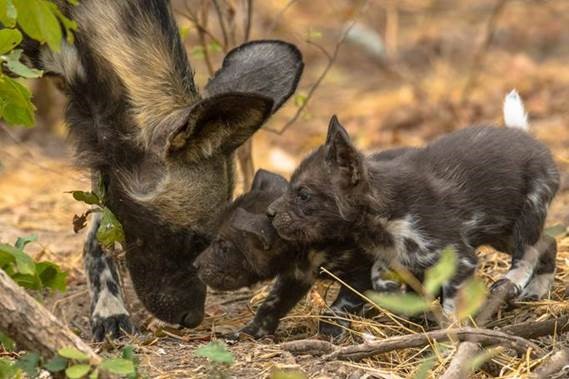 After about a month, the pups started to shift from Blacktip’s milk to solid regurgitated food. Each morning, while the pack headed off to hunt, I would sit patiently waiting in perfectly quiet stillness for them to return with the pups remaining hidden in their hole. Keeping me company was a babysitter, who maintained a vigilant watch on the den performing regular patrols around its perimeters.
After about a month, the pups started to shift from Blacktip’s milk to solid regurgitated food. Each morning, while the pack headed off to hunt, I would sit patiently waiting in perfectly quiet stillness for them to return with the pups remaining hidden in their hole. Keeping me company was a babysitter, who maintained a vigilant watch on the den performing regular patrols around its perimeters.
When the pack returned, there would always be an eruption of excitement as 12 hungry little mouths twittered like canneries and mobbed any adult willing to regurgitate some of their kill.
Over the three months at the den, I watched the pups’ strength and confidence grow, as did their individual characters. Finally, it was time for the pack to leave the den’s confines and slip into the big wide world and the norms of a nomadic lifestyle.
It has now been three months since they left the den and the pack is now three pups down, each succumbing to attacks from hyena. This is sadly to be expected; hyena and lion are the painted wolves’ natural nemesis.
The pack has now established its territory of a hundred square kilometres, which they continually circuit over a 10-day cycle. They never stay in one particular area for long, so that their takings from each herd are limited to one or two animals and never extend to a ruthless plunder.
As I sit in with them now, quietly sleeping, I reflect on what is now becoming a normal day for me. I rolled out of camp before dawn searching the meandering dirt roads for any sign of paw prints. I knew where I had left the pack last night, so they wouldn’t have moved far. There was no full moon to light their way.
Eventually I see fresh tracks heading into the bush. I pull my car off the road and swig down a litre of water – this could be a long hot morning. Grabbing my camera, its 400mm lens and a tripod, I check my bear-banger on my belt. It fires a flare and makes a large bang – my only defence against an over inquisitive lion. With all my senses heightened, I head off to find them.
It takes fifteen minutes. Through a tangle of branches, a huddle of Mickey Mouse ears become clear. They have stopped to rest on their morning hunt, allowing me to catch up. They see me approaching but barely stir as I position myself to take a few shots, the sun rising warmly behind me.
Before long, Blacktip signals it’s time to get breakfast and they head off into the light morning breeze. I follow them for a good hour. Eventually they spot a herd of oblivious impala and drop into stalking mode – single file, backs straight and eyes focussed. I duck behind a tree so as not to give them away – I am a lot less stealthy.
They are close when the impalas spot them. The herd starts to bolt which lets slip these dogs of war. It is pandemonium. Wolves and impala are running everywhere. The belief that the wolves use telepathy to strategise when hunting is a fallacy – it is mayhem – every dog for itself.
Two wolves close in on an impala and with a leap, bring it down. More pack members quickly arrive and in a cloud of dust the impala is disembowelled and dispatched. It looks savage, but the impala’s ordeal lasts only a few seconds, limiting any suffering.
After a few mouthfuls, the pups arrive and take their place at the head of the table. The wolves always ensure the young or injured have their fill first and Blacktip, like any great general, will always be the last to feed.
But there was enough food for all this morning and it made me happy to see the hungry wolves’ bellies comfortably expand in front of my camera. When there is little left of the carcass the pups began to play after dinner games with the remains. It was slightly gruesome to watch, but witnessing their abundant joy makes anything they do forgivable.
Eventually, they left the kill scene to find some cool shade to protect them from the heat of the day and I returned to my camp. It had been yet another life expanding experience with the painted wolves and I was delighted with the pictures they had given me.
Now, in the late afternoon. I have re-joined them and sitting by myself, I watch over these gentle peacefully sleeping wolves. They will soon jump up and perform their greeting ceremony – the highlight of any painted wolf experience. It is a daily ritual of joy where they wake in unison and leap and lick and nuzzle and nudge and bite and barge and bound and burst with joy at seeing one another again, even though they’ve been asleep together all day long.
I am deeply privileged to get to spend so much time with these remarkable creatures. The painted wolves have etched a deep groove in my heart. And what I have learnt for certain is that, when you get the chance to see them, they will leave more than a scratch upon yours.
The best way to see these magnificent creatures is where they thrive in the national parks of Zimbabwe and Botswana with responsible authentic safari operator African Bush Camps in their stunning tented camps.
WILDFOOT Travel offer 3 night exclusive safaris at selected African Bush Camps in Mana Pools National Park, Zimbabwe guided privately by Nick Dyer, please contact Simon for more information – [email protected]
